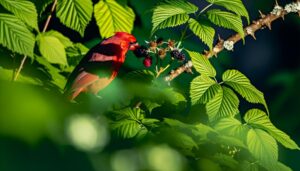Quick Guide to Identify Black Cardinal Philodendron
Black Cardinal Philodendron (Philodendron 'Black Cardinal') is distinguishable by nearly black, elongated heart-shaped leaves with a smooth and glossy texture due to anthocyanin pigments. New leaves emerge vibrant burgundy or deep green, darkening over time.
The plant has robust, deep burgundy stems with short internodal spacing and a compact, upright growth pattern forming a rosette. It typically reaches 2-3 feet in height and spread.
Thrives in bright, indirect light with well-draining soil, a pH range of 5.5-6.5, and requires watering when the top inch of soil is dry. Exploring its specific nuances and care will further your understanding.
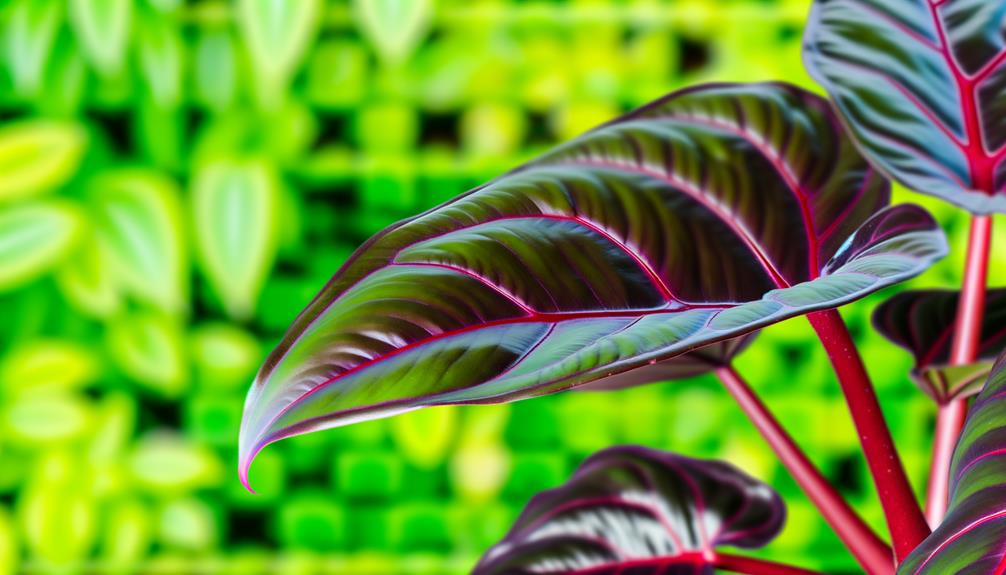
Key Takeaways
- Nearly ebony-hued leaves darken from burgundy or deep green due to anthocyanin pigments.
- Elongated heart-shaped leaves with a glossy, smooth, and velvety texture.
- Robust, deep burgundy stems with short internodal spacing and compact, upright growth.
- Reaches 2-3 feet in height with broad, dense, clustered foliage up to 8 inches long.
- Prefers bright, indirect light and well-draining, nutrient-rich soil with pH 5.5-6.5.
Leaf Color
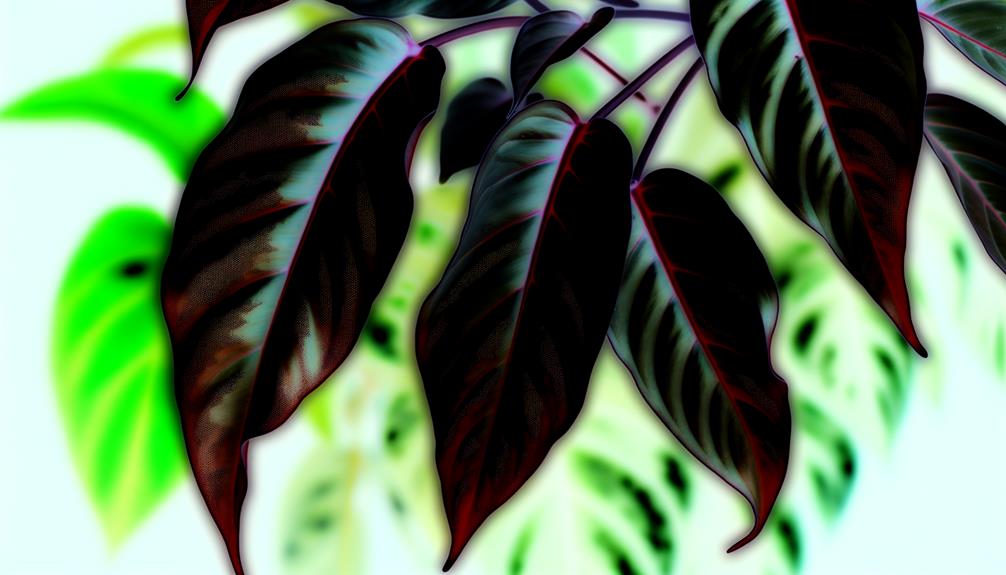
The Black Cardinal Philodendron (Philodendron 'Black Cardinal') is celebrated for its eye-catching foliage, which showcases a dark, nearly ebony hue that deepens with maturity. This rich coloration is a result of anthocyanin pigments, which build up in the leaf tissues.
When young, the leaves often exhibit a vibrant burgundy or deep green color, gradually darkening as the plant matures. This colorful change is a sign of a robust specimen and can be affected by light exposure, with dimmer light conditions often enhancing the darker tones.
The leaves' shiny surface adds to the plant's charm, reflecting light in a manner that accentuates the intricate venation. Grasping these color traits is crucial for precise identification and ideal growth conditions of Philodendron 'Black Cardinal'.
Leaf Shape
When evaluating the leaf shape of Philodendron 'Black Cardinal', one should observe its elongated heart shape, which is characteristic of the species.
Additionally, the leaves exhibit a smooth and glossy texture, enhancing their visual appeal and distinctive identification.
These morphological features are critical in distinguishing P. 'Black Cardinal' from other Philodendron cultivars.
Elongated Heart Shape
Characterized by their elongated heart shape, the leaves of the Black Cardinal Philodendron (Philodendron erubescens 'Black Cardinal') exhibit a unique morphology that distinguishes this cultivar from other species within the genus.
This distinctive leaf shape can be identified by several notable features:
- Length-to-Width Ratio: Typically, the leaves possess a higher length-to-width ratio compared to other Philodendron species, giving them a more elongated appearance.
- Apex and Base: The leaf apex is acutely pointed, while the base is broadly cordate, forming a heart-like shape.
- Venation Pattern: The primary and secondary veins are prominently displayed, contributing to the structural integrity and aesthetic appeal of the foliage.
Understanding these characteristics is essential for accurate identification and appreciation of this unique Philodendron cultivar.
Smooth, Glossy Texture
Exhibiting a smooth, glossy texture, the leaves of Philodendron erubescens 'Black Cardinal' reflect light in a manner that enhances their striking visual appeal and highlights their intricate venation patterns. This characteristic sheen is attributable to the leaf's epidermal cells, which are tightly packed and coated with a waxy cuticle, reducing water loss and contributing to the plant's overall resilience.
The glossy surface not only augments the aesthetic value but also plays a functional role, facilitating efficient photosynthesis by maximizing light absorption. Additionally, the smooth texture makes the leaves less prone to pest infestation, as insects find it difficult to establish a foothold. Consequently, the glossy leaves are both an ornamental and practical feature of the Black Cardinal Philodendron.
Leaf Texture
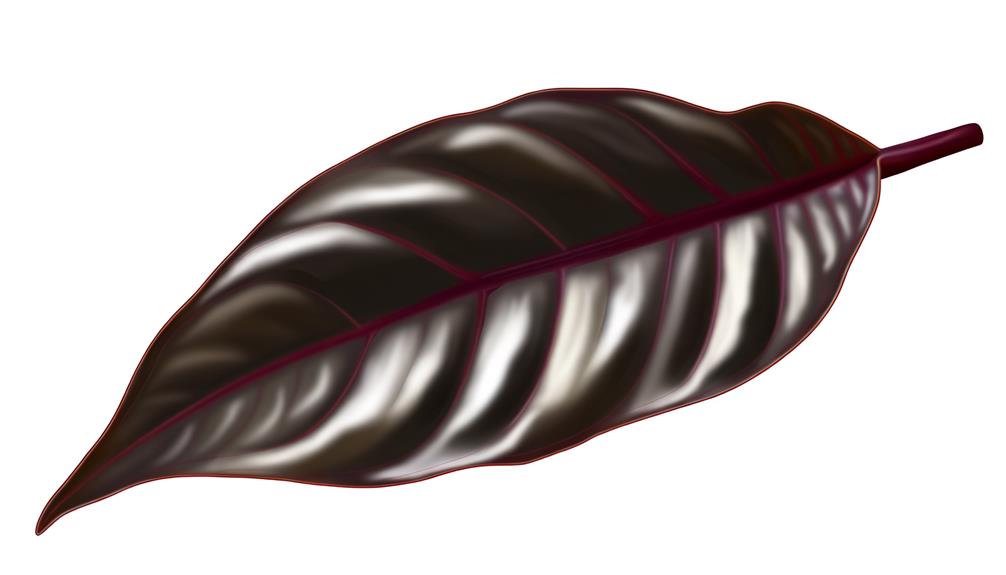
The leaf texture of the Philodendron 'Black Cardinal' showcases a smooth and velvety feel, which is a distinguishing characteristic of the species.
The adaxial surface is remarkably glossy, contributing to its ornamental value.
Additionally, the texture of new growth presents a delicate contrast, initially appearing softer and gradually developing the mature glossy finish.
Smooth and Velvety Feel
A notable feature of the Black Cardinal Philodendron (Philodendron 'Black Cardinal') is its exceptionally smooth and velvety leaf texture. This distinctive tactile quality is attributed to the plant's epidermal layer, which is specifically adapted to reduce water loss and enhance photosynthetic efficiency.
The velvety texture can be examined through:
- Touch Sensation: The leaves feel soft and plush, akin to a fine fabric.
- Microscopic Examination: Under magnification, the leaf surface reveals fine, hair-like structures known as trichomes, which contribute to the smooth feel.
- Comparative Analysis: When compared to other Philodendron varieties, Black Cardinal's leaves exhibit a more pronounced velvety texture, aiding in its identification.
This unique characteristic not only serves a functional role but also adds to the aesthetic appeal of the plant.
Glossy Leaf Surface
Glossy leaf surfaces of the Black Cardinal Philodendron (Philodendron 'Black Cardinal') result from the plant's specialized cuticular layer, which reflects light and reduces water loss. This cuticular layer, composed of cutin and waxes, forms a hydrophobic barrier that limits transpiration.
The glossiness also aids in maximizing photosynthetic efficiency by optimizing light absorption. The surface's sheen is particularly pronounced on mature leaves, offering a striking visual contrast against the plant's dark, almost black foliage.
This reflective quality is not only aesthetic but functional, providing an adaptive advantage in various light conditions. The interplay of light and texture is a key identifying feature, distinguishing Philodendron 'Black Cardinal' from other Philodendron species with less lustrous foliage.
New Growth Texture
Emerging leaves of the Black Cardinal Philodendron (Philodendron 'Black Cardinal') exhibit a distinctively smooth and leathery texture, which gradually transforms as they mature. This transformation is marked by several stages that are essential for proper identification:
- Initial Stage: The nascent leaves are exceptionally smooth, almost waxy to the touch, indicating healthy development.
- Intermediate Stage: As they unfurl, the leaves retain their leathery texture but begin to exhibit subtle veining, enhancing their structural integrity.
- Mature Stage: Fully developed leaves display a slightly rougher surface with pronounced, deep-green pigmentation, indicating maturity.
Understanding these textural changes is vital for identification and care, ensuring the plant's health and best growth.
Stem Characteristics
Characterized by its robust and sturdy structure, the stem of the Black Cardinal Philodendron (Philodendron erubescens 'Black Cardinal') exhibits a deep burgundy hue, gradually darkening as the plant matures. This morphological feature not only adds to its aesthetic appeal but also serves as a key identification marker.
The stem's thickness and rigidity support the plant's overall architecture, ensuring stability. Nodes along the stem are spaced evenly, from which petioles and leaves emerge. Internodal spacing is relatively short, contributing to the plant's compact growth form.
Additionally, the stem surface is smooth, devoid of any pronounced ridges or spines, enhancing its sleek appearance. Observing these characteristics can assist in accurately identifying the Black Cardinal Philodendron.
Growth Habit

In addition to its distinctive stem, the growth habit of the Black Cardinal Philodendron (Philodendron erubescens 'Black Cardinal') is another critical aspect for accurate identification. This philodendron exhibits a self-heading growth pattern, meaning it does not trail or climb like other species within the genus. Instead, it maintains a compact, upright form.
Key characteristics include:
- Rosette Formation: The leaves emerge in a rosette pattern, giving the plant a bushy appearance.
- Short Internodes: The segments between nodes are remarkably short, contributing to its dense, clustered look.
- Vertical Growth: Stems grow vertically rather than sprawling, ensuring minimal support is needed for structural stability.
These growth habits aid in distinguishing the Black Cardinal Philodendron from other philodendron species.
Size and Maturity
Upon reaching maturity, the Black Cardinal Philodendron (Philodendron erubescens 'Black Cardinal') typically achieves a height of approximately 2 to 3 feet with a similar spread, making it suitable for both indoor and controlled outdoor environments.
This compact yet robust growth habit allows it to fit well in various spatial settings without overwhelming its surroundings. The mature leaves exhibit a striking dark burgundy to almost black hue, adding a dramatic visual appeal.
The foliage is generally broad, glossy, and heart-shaped, measuring up to 8 inches in length. The plant's sturdy stems provide adequate support for the dense leaf clusters.
Understanding the size and maturity of this species is essential for best placement and care, ensuring its long-term health and aesthetic appeal.
Lighting Needs

Philodendron 'Black Cardinal' thrives in bright, indirect light, which optimizes its photosynthetic efficiency and foliage coloration.
Direct sunlight should be avoided as it can cause leaf scorching and pigment degradation.
In low-light conditions, growth may be slower, but strategic placement and supplemental lighting can mitigate these effects.
Ideal Light Conditions
Ideal light conditions for Philodendron erubescens 'Black Cardinal' involve bright, indirect sunlight to prevent leaf scorching while promoting healthy growth. This tropical species thrives under conditions that mimic its natural understory habitat.
Key considerations include:
- Light Intensity: Ensure the plant receives filtered sunlight, ideally through a sheer curtain, to maintain peak photosynthesis without damaging the foliage.
- Duration: Aim for 10-12 hours of indirect light daily, as prolonged darkness can hinder growth and reduce vigor.
- Positioning: Place the plant near east or north-facing windows; these orientations typically offer the gentlest light.
Avoid Direct Sunlight
Direct sunlight exposure can cause significant damage to Philodendron erubescens 'Black Cardinal', leading to leaf burn and overall stress on the plant. This tropical species thrives in environments that mimic the dappled light conditions of its natural habitat.
Exposure to intense, direct sunlight can result in chlorophyll degradation, manifesting as yellowing or browning of the foliage. Consequently, the plant's photosynthetic efficiency is impaired, affecting its growth and essentiality.
Placing the 'Black Cardinal' in an area with indirect or filtered light will help maintain its dark, glossy foliage and promote prime health. Utilizing sheer curtains or positioning the plant in an east-facing window can effectively mitigate the adverse effects of direct sunlight, ensuring the plant's longevity and aesthetic appeal.
Adjusting for Low Light
In low-light conditions, Philodendron erubescens 'Black Cardinal' can still thrive, provided certain adjustments are made to meet its lighting needs. This species, known for its deep burgundy foliage, requires specific care to support growth in less than ideal lighting.
- Supplemental Lighting: Introduce artificial light sources such as LED grow lights to mimic natural sunlight.
- Proper Placement: Position the plant near windows with indirect light, avoiding areas with complete darkness.
- Regular Rotation: Rotate the plant periodically to support even light distribution, preventing asymmetrical growth.
Soil Preferences
The Black Cardinal Philodendron (Philodendron 'Black Cardinal') thrives in well-ventilated, nutrient-rich soil with excellent drainage capabilities. Best soil composition includes a blend of peat moss, perlite, and pine bark, which guarantees sufficient aeration and prevents root rot.
A pH level ranging between 5.5 and 6.5 is ideal, as it maintains nutrient availability while minimizing the risk of nutrient lockout. Including organic matter such as compost can improve soil fertility, promoting vigorous growth and vibrant foliage.
Maintaining the substrate loose and well-draining is essential to avoid waterlogging, which can cause harmful root diseases. The implementation of these soil preferences will greatly contribute to the overall health and aesthetic appeal of the Black Cardinal Philodendron.
Watering Requirements
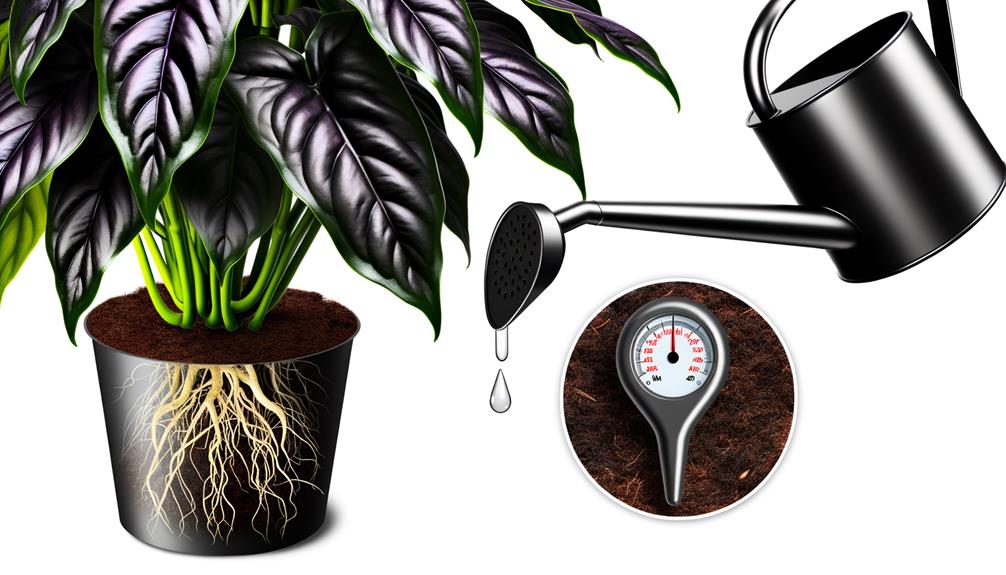
Securing ideal soil conditions is only part of the equation; the Black Cardinal Philodendron also demands a precise watering regimen to thrive. Philodendron erubescens 'Black Cardinal' benefits from a balance between hydration and aeration.
Overwatering can lead to root rot, while underwatering may stunt growth. To achieve prime watering:
- Frequency: Watering should occur when the top inch of soil becomes dry.
- Method: Utilize a thorough soaking, guaranteeing water drains from the bottom of the pot.
- Seasonal Adjustment: Reduce watering frequency during the dormant winter months and increase it during the growing season.
This regimen guarantees that the plant's roots remain healthy, facilitating strong growth and maintaining the distinctive dark foliage that characterizes the Black Cardinal Philodendron.
Common Look-alikes
Distinguishing the Black Cardinal Philodendron from its common look-alikes, such as Philodendron 'Imperial Red' and Philodendron 'Congo Rojo', necessitates a detailed examination of leaf coloration, shape, and growth patterns.
Philodendron 'Black Cardinal' (Philodendron erubescens) exhibits dark, almost black foliage with a glossy texture, contrasted by the lighter, reddish hues of Philodendron 'Imperial Red' (Philodendron erubescens 'Imperial Red'). Additionally, 'Congo Rojo' (Philodendron 'Rojo Congo') features larger, broader leaves with a more pronounced red undertone.
Leaf shape is another indicator; 'Black Cardinal' leaves are more elongated and narrower compared to the wider, rounder leaves of its counterparts. Growth patterns also vary, with 'Black Cardinal' being more compact and slower-growing than the faster, more expansive growth of 'Congo Rojo'.
Conclusion
To conclude, the Black Cardinal Philodendron (Philodendron 'Black Cardinal') emerges as a mysterious botanical treasure, marked by its deep, nearly velvety leaves, oval shape, and distinct stem structure.
Its way of growing and particular environmental needs, such as indirect sunlight and soil that drains well, also help define its character.
Possible confusion may arise due to resemblances with other Philodendron types and related plant families.
Grasping these subtleties allows for precise identification, nurturing an admiration for the plant's unique beauty and ecological demands.


